PORSCHE CAYNNE 2008 1.G Information Manual
Manufacturer: PORSCHE, Model Year: 2008, Model line: CAYENNE, Model: PORSCHE CAYENNE 2008 1.GPages: 95, PDF Size: 3.37 MB
Page 31 of 95
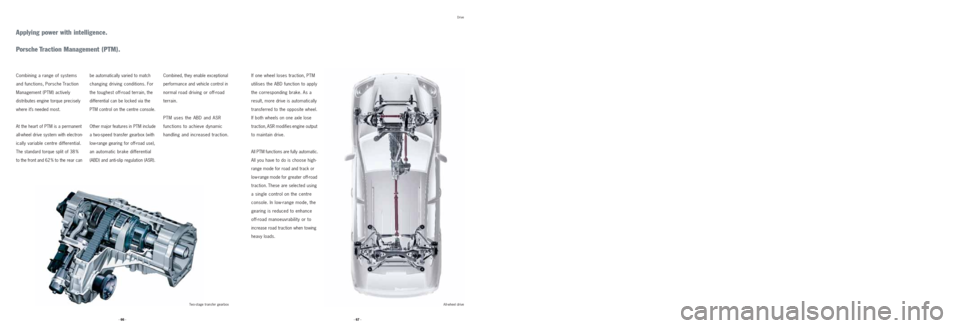
Drive
Applying power with intelligence.
Porsche Traction Management (PTM).
If one wheel loses traction, PTM
utilises the ABD function to apply
the corresponding brake. As a
result, more drive is automatically
transferred to the opposite wheel.
If both wheels on one axle lose
traction, ASR modifies engine output
to maintain drive.
All PTM functions are fully automatic.
All you have to do is choose high-
range mode for road and track or
low-range mode for greater off-road
traction. These are selected using
a single control on the centre
console. In low-range mode, the
gearing is reduced to enhance
off-road manoeuvrability or to
increase road traction when towing
heavy loads.
be automatically varied to match
changing driving conditions. For
the toughest off-road terrain, the
differential can be locked via the
PTM control on the centre console.
Other major features in PTM include
a two-speed transfer gearbox (with
low-range gearing for off-road use),
an automatic brake differential
(ABD) and anti-slip regulation (ASR).
Combining a range of systems
and functions, Porsche Traction
Management (PTM) actively
distributes engine torque precisely
where it’s needed most.
At the heart of PTM is a permanent
all-wheel drive system with electron-
ically variable centre differential.
The standard torque split of 38 %
to the front and 62 % to the rear canCombined, they enable exceptional
performance and vehicle control in
normal road driving or off-road
terrain.
PTM uses the ABD and ASR
functions to achieve dynamic
handling and increased traction.
All-wheel drive Two-stage transfer gearbox
· 67 · · 66 ·
Page 32 of 95
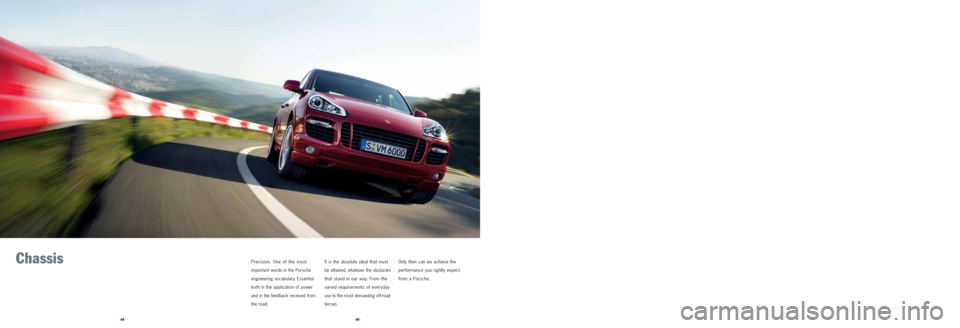
Chassis Precision. One of the most
important words in the Porsche
engineering vocabulary. Essential
both in the application of power
and in the feedback received from
the road.
It is the absolute ideal that must
be attained, whatever the obstacles
that stand in our way. From the
varied requirements of everyday
use to the most demanding off-road
terrain.
Only then can we achieve the
performance you rightly expect
from a Porsche.
· 69 · · 68 ·
Page 33 of 95

Cayenne Turbo
1. Compressed air cylinder
2. Air suspension and PASM
control unit
3. Air suspension struts
4. Air suspension compressor5. Catalytic converter
6. Silencers
7. Gear selector unit
(Tiptronic S)
8. Tiptronic S transmission9. Two-stage transfer
gearbox with lockable
centre differential
10. Double wishbone
suspension
11. Multi-link suspension
10
11
1
1
2
3
3
34
5
7
89
6
· 71 · · 70 ·
Chassis
Page 34 of 95
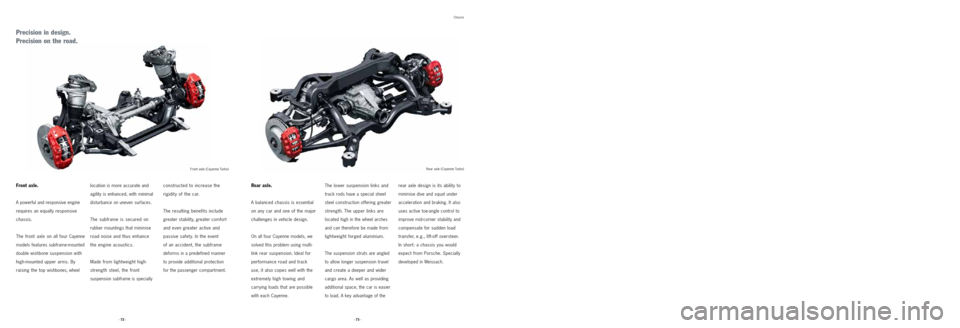
Chassis
Precision in design.
Precision on the road.
location is more accurate and
agility is enhanced, with minimal
disturbance on uneven surfaces.
The subframe is secured on
rubber mountings that minimise
road noise and thus enhance
the engine acoustics.
Made from lightweight high-
strength steel, the front
suspension subframe is specially
constructed to increase the
rigidity of the car.
The resulting benefits include
greater stability, greater comfort
and even greater active and
passive safety. In the event
of an accident, the subframe
deforms in a predefined manner
to provide additional protection
for the passenger compartment.
Front axle.
A powerful and responsive engine
requires an equally responsive
chassis.
The front axle on all fourCayenne
models features subframe-mounted
double wishbone
suspension with
high-mounted upper arms. By
raising the top
wishbones, wheel
Rear axle.
A balanced chassis is essential
on any car and one of the major
challenges in vehicle design.
On all four Cayenne models, we
solved this problem using multi-
link rear suspension. Ideal for
performance road and track
use, it also copes well with the
extremely high towing and
carrying loads that are possible
with each Cayenne.
The lower suspension links and
track rods have a special sheet
steel construction offering greater
strength. The upper links are
located high in the wheel arches
and can therefore be made from
lightweight forged aluminium.
The suspension struts are angled
to allow longer suspension travel
and create a deeper and wider
cargo area. As well as providing
additional space, the car is easier
to load. A key advantage of the
rear axle design is its ability to
minimise dive and squat under
acceleration and braking. It also
uses active toe-angle control to
improve mid-corner stability and
compensate for sudden load
transfer, e.g., lift-off oversteer.
In short: a chassis you would
expect from Porsche. Specially
developed in Weissach.
Front axle (Cayenne Turbo) Rear axle (Cayenne Turbo)
· 73 · · 72 ·
Page 35 of 95

Chassis
Exceptional power requires accurate direction.
Steering.Tough for off road, light for the track, stylish for any terrain.
Wheels.
The electrically adjustable steer-
ing column has a driver-selectable
‘Easy Entry’ function, which raises
the steering wheel towards the
dashboard whenever you enter
or leave the car. The comfort and
sports seat options (standard on
Cayenne GTS and Cayenne Turbo)
have a comfort memory package
that stores your preferred
wheel position as well as seat
and exterior mirror settings.
The steering column consists of
multiple collapsing sections linked
by three universal joints. A special
deformation element offering
70 mm of travel provides a high
level of safety in the event of front
impact.
Servotronic.
Servotronic is a speed-sensitive
power steering system available
as an option on all Cayenne
models.
At higher speeds, the steering
becomes firmer, inputs are more
precise and driver comfort is
greatly enhanced.
At lower speeds, it enables easy
manoeuvrability and parking. For optimum manoeuvrability, on
and off road, all Cayenne models
have variable-ratio steering
and special valve settings on
the power-steering system. Lock-
to-lock travel is a modest
2.65 turns, while the turning
circle is just 11.7 metres.
The steering wheel can be adjusted
by 50 mm for reach and 40 mm
for height. Both adjustment options
are electrically assisted on
the Cayenne GTS and Cayenne
Turbo. Electric adjustment is also
available as an option on the
Cayenne and Cayenne S as part
of the optional comfort or sports
seat package (each with comfort
memory package). The optional
padded steering wheel (standard
on Cayenne GTS) brings added
sporting style to each model.
the multi-purpose display in the
instrument cluster. Standard wheel fitments are as
follows: 17-inch Cayenne alloys on
the Cayenne, 18-inch Cayenne S II
on the Cayenne S, 21-inch
Cayenne Sport on the Cayenne
GTS and 19-inch Cayenne Design
on the Cayenne Turbo.
For a more personal touch, you
can choose from a range of
wheel options (see page 160).
Tyre Pressure Monitoring
(TPM).
The optional TPM warns of any
drop in pressure via the on-board
computer display. In addition,
the driver can check the individual
pressures in all four wheels via
17-inch Cayenne wheel 18-inch Cayenne S II wheel
21-inch Cayenne Sport wheel 19-inch Cayenne Design wheel
· 75 · · 74 ·
Page 36 of 95

Chassis
Active damping adjustment for optimum performance and comfort.
Porsche Active Suspension Management (PASM).
Both systems are optional on
the Cayenne and Cayenne S. The
Cayenne GTS has an exclusive
combination of PASM and high-
performance steel-sprung suspen-
sion (ride height lowered by 24 mm).
During performance driving or
heavy off-road use, there is a
greater tendency for the body
to roll. PASM prevents this from
happening, thereby improving
stability and occupant comfort.
PASM has three setup modes:
‘Comfort’, ‘Normal’ and ‘Sport’.
In all three cases, the system
uses a series of sensors to
monitor the movement of the
body, e.g., under acceleration and
braking or on poor road surfaces.
It also gathers data on lateral
acceleration, steering angle, brake
pressure and engine torque. The
PASM control unit then evaluates
this information and modifies the
damping forces in accordance
with the selected mode.
PASM remains active at
all times, adapting to the
changing conditions.
If the road surface deteriorates
while travelling in ‘Sport’ mode,
for instance, the system
immediately changes to a softer
rating, thereby improving road
contact. When the road surface
improves, PASM automatically
reverts to the original, harder
rating. This not only increases
stability and safety, it also
enhances comfort.
PASM is an electronic damping
control system. It offers continuous
adjustment of individual damping
forces based on current road
conditions and driving style. PASM
is standard on the Cayenne Turbo
in conjunction with air suspension.
· 77 · · 76 ·PASM control with ‘Comfort’, ’Normal’ and ‘Sport’ options
Page 37 of 95
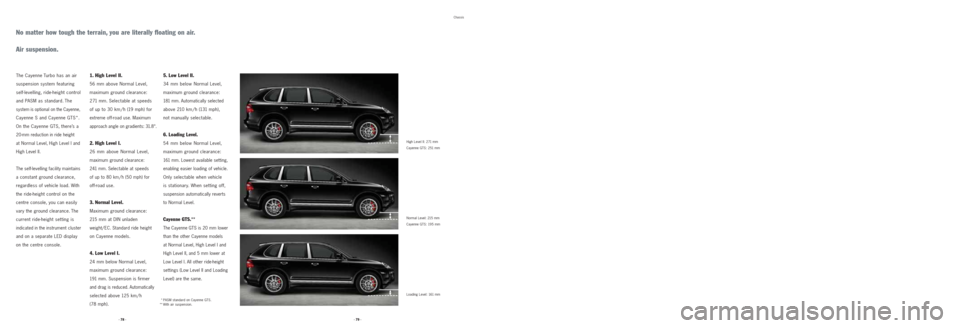
Chassis
No matter how tough the terrain, you are literally floating on air.
Air suspension.
High Level II: 271 mm
Cayenne GTS: 251 mm
Normal Level: 215 mm
Cayenne GTS: 195 mm
Loading Level: 161 mm
1. High Level II.
56 mm above Normal Level,
maximum ground clearance:
271 mm. Selectable at speeds
of up to 30 km / h (19 mph) for
extreme off-road use. Maximum
approach angle on gradients: 31.8°.
2. High Level I.
26 mm above Normal Level,
maximum ground clearance:
241 mm. Selectable at speeds
of up to 80 km / h (50 mph) for
off-road use.
3. Normal Level.
Maximum ground clearance:
215 mm at DIN unladen
weight/ EC. Standard ride height
on Cayenne models.
4. Low Level I.
24 mm below Normal Level,
maximum ground clearance:
191 mm. Suspension is firmer
and drag is reduced. Automatically
selected above 125 km / h
(78 mph).
5. Low Level II.
34 mm below Normal Level,
maximum ground clearance:
181 mm. Automatically selected
above 210 km / h (131 mph),
not manually selectable.
6. Loading Level.
54 mm below Normal Level,
maximum ground clearance:
161 mm. Lowest available setting,
enabling easier loading of vehicle.
Only selectable when vehicle
is stationary. When setting off,
suspension automatically reverts
to Normal Level.
Cayenne GTS.**
The Cayenne GTS is 20 mm lower
than the other Cayenne models
at Normal Level, High Level I and
High Level II, and 5 mm lower at
Low Level I. All other ride-height
settings (Low Level II and Loading
Level) are the same.
The Cayenne Turbo has an air
suspension system featuring
self-levelling, ride-height control
and PASM as standard. The
system is optional on the Cayenne,
Cayenne S and Cayenne GTS*.
On the Cayenne GTS, there’s a
20-mm reduction in ride height
at Normal Level, High Level I and
High Level II.
The self-levelling facility maintains
a constant ground clearance,
regardless of vehicle load. With
the ride-height control on the
centre console, you can easily
vary the ground clearance. The
current ride-height setting is
indicated in the instrument cluster
and on a separate LED display
on the centre console.
** PASM standard on Cayenne GTS.
** With air suspension.
· 79 · · 78 ·
Page 38 of 95
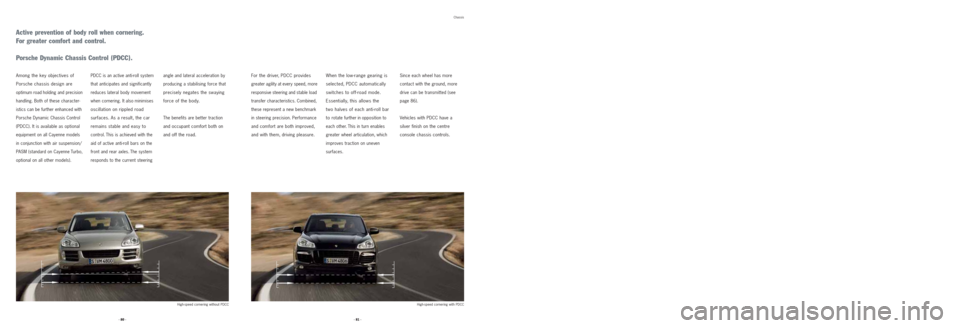
Chassis
Active prevention of body roll when cornering.
For greater comfort and control.
Porsche Dynamic Chassis Control (PDCC).
PDCC is an active anti-roll system
that anticipates and significantly
reduces lateral body movement
when cornering. It also minimises
oscillation on rippled road
surfaces. As a result, the car
remains stable and easy to
control. This is achieved with the
aid of active anti-roll bars on the
front and rear axles. The system
responds to the current steeringangle and lateral acceleration by
producing a stabilising force that
precisely negates the swaying
force of the body.
The benefits are better traction
and occupant comfort both on
and off the road.For the driver, PDCC provides
greater agility at every speed, more
responsive steering and stable load
transfer characteristics. Combined,
these represent a new benchmark
in steering precision. Performance
and comfort are both improved,
and with them, driving pleasure.
When the low-range gearing is
selected, PDCC automatically
switches to off-road mode.
Essentially, this allows the
two halves of each anti-roll bar
to
rotate further in opposition to
each other. This in turn enables
greater wheel articulation, which
improves traction on uneven
surfaces.Since each wheel has more
contact with the ground, more
drive can be transmitted (see
page 86).Vehicles with PDCC have a
silver finish on the centre
console chassis controls. Among the key objectives of
Porsche chassis design are
optimum road holding and precision
handling. Both of these character-
istics can be further enhanced with
Porsche Dynamic Chassis Control
(PDCC). It is available as optional
equipment on all Cayenne models
in conjunction with air suspension/
PASM (standard on Cayenne Turbo,
optional on all other models).
High-speed cornering without PDCC High-speed cornering with PDCC
· 81 · · 80 ·
Page 39 of 95
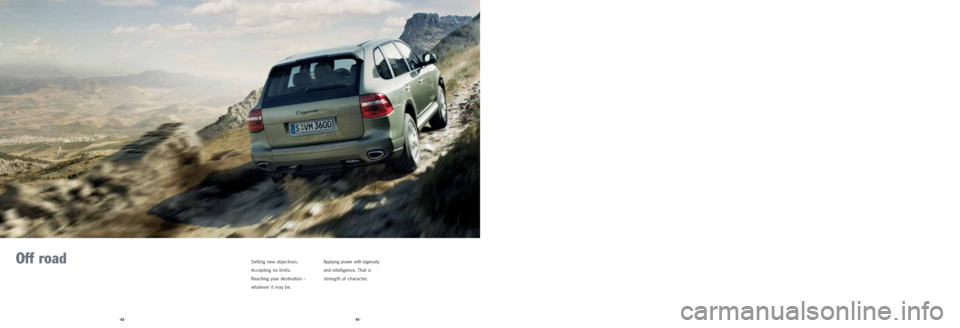
Off road Setting new objectives.
Accepting no limits.
Reaching your destination –
whatever it may be.
Applying power with ingenuity
and intelligence. That is
strength of character.
· 83 · · 82 ·
Page 40 of 95
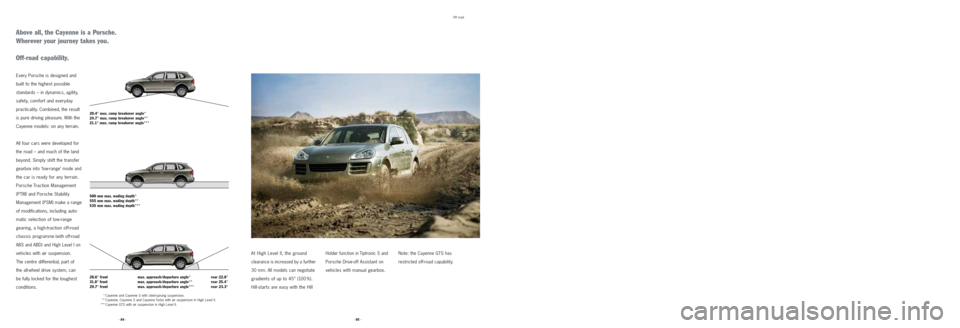
Off road
Every Porsche is designed and
built to the highest possible
standards – in dynamics, agility,
safety, comfort and everyday
practicality. Combined, the result
is pure driving pleasure. With the
Cayenne models: on any terrain.
All four cars were developed for
the road – and much of the land
beyond. Simply shift the transfer
gearbox into ‘low-range’ mode and
the car is ready for any terrain.
Porsche Traction Management
(PTM) and Porsche Stability
Management (PSM) make a range
of modifications, including auto-
matic
selection of low-range
gearing, a high-traction off-road
chassis
programme (with off-road
ABS and
ABD) and High Level I on
vehicles
with air suspension.
The centre differential, part of
the all-wheel drive system, can
be fully locked for the toughest
conditions.At High Level II, the ground
clearance is increased by a further
30 mm. All models can negotiate
gradients of up to 45° (100 %).
Hill-starts are easy with the Hill
Holder function in Tiptronic S and
Porsche Drive-off Assistant on
vehicles with manual gearbox.
28.6° front max. approach /departure angle * rear 22.8°
31.8° front max. approach /departure angle * * rear 25.4°
29.7° front max. approach /departure angle * * * rear 23.3°
20.4° max. ramp breakover angle *
24.7° max. ramp breakover angle * *
21.1° max. ramp breakover angle***
500 mm max. wading depth *
555 mm max. wading depth * *
535 mm max. wading depth * * *
*** Cayenne and Cayenne S with steel-sprung suspension.
*** Cayenne, Cayenne S and Cayenne Turbo with air suspension in High Level II.
*** Cayenne GTS with air suspension in High Level II.
Note: the Cayenne GTS has
restricted off-road capability.
· 85 · · 84 ·
Above all, the Cayenne is a Porsche.
Wherever your journey takes you.
Off-road capability.